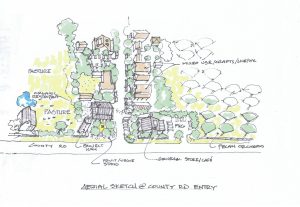In the past few years, the Urban Land Institute has recognized that integrating food and farming into urban, suburban and rural real estate development projects is a rapidly growing trend. In addition to creating a dynamic platform for food production, social engagement and education, farm-centric communities can also support more vibrant and just regional food systems.
Integrating farms into neighborhoods presents several benefits, here are seven reasons to add agriculture to your community.

1. Preserves Land for Agriculture
Agriculture has long been pushed away from urban growth. By presenting it as a part of this growth, it has the opportunity to become the heart of a community. Preserving farmland close to where people live creates the opportunity for people to be intimately connected to the land, their food and the farmers who grow it.
2. Provides a New Model for Sustainable Farming
Beyond preserving the land, centering developments around agriculture cultivates healthy communities that promote healthy lifestyles around strong connections between people and the land, their food and their neighbors. This integrated economic model, instead of displacing farmland for housing development, can be a catalyst in preserving a portion of the farm land for nourishing the growing community. Development of these communities, or Agrihoods, can provide the land, capital, infrastructure and time for a community farm to take root and thrive.
3. Increases Access to Healthy Local Food
The lack of access to healthy and nutritious food is increasing the disparities between higher-income and lower-income communities. Underserved communities struggle with food security because of the barriers, such as cost and locale, caused by the lack of agricultural access and education. Adding an agricultural element within developments allows all residents to produce and consume organic food with little cost because we reduce the need for transportation and distribution.

4. Encourages Community Involvement
Taking production further, the cooperative opportunities created by these communities motivates residents to socialize more with each other while engaging with the land. Think of developments like Serenbe, where the farming element has allowed the residents to not only grow food together, but enjoy it together, whether at home or at their restaurants and bake shops. Beyond the farms, communities create scenic trails, inviting families, friends and tourists, to explore the community together and strengthen their relationships with the land, their food, their farmers and themselves.
5. Promotes Agricultural Education
As “Citizen Farmers,” residents learn how to give the land more than what they take from it, facilitating action that fosters healthier, more sustainable food systems. Adding agriculture to a community promotes education in farming, food production and land preservation across the spectrum. This enables primary schools to integrate agriculture into their curriculum. This gives breadth for Citizen Farmer workshops to teach adults to engage more in their community. This also provides a platform for next-gen training to both teach and practice sustainable farming for the future.
6. Supports Local Economy
Local farms help keep food dollars in the local economy and support small businesses, farmers, and entrepreneurs. Community farms can serve as platforms for products and services that grow from the farm, such as value-added food products, garden education and management services, programs and events on the farm.
Imagine your friend owns one of the farms and just harvested a fresh crop of peas and butternut squash. You work at a new, local farm-to-table restaurant and your boss is thinking of a new seasonal item. You look in your “Citizen Farmer” book and see the recipe for a Pea and Butternut Squash stew. You just bridged the connection between these two businesses – the restaurant can incorporate local food and your friend’s farm gets supported – and you did it all on a local level.

7. Benefits the Natural Environment
We not only want to reduce our negative impact on the environment, but also want to find ways to positively impact it. We’re stewards of the land and it is our collective responsibility to retain and enhance its quality and abundance of its nature capital, such as water and soil. Adding agriculture to the community does this in several ways:
Making food production and consumption hyperlocal decreases food miles, the distance food travels to the table, which reduces our carbon footprint.
Waste is diverted when production is local with no need to wrap in plastic, fill up boxes, etc.
Building up soil fertility through organic farming practices such as cover crops, compost and animals helps store carbon in the soil, reduce need for irrigation and fertilizer and increase the productivity of the land for food production.
Environmental awareness is increased because of the way the community interacts with agriculture through educational programs at schools, camps and others.
These reasons encompass one critical purpose, to give back to the Earth what we take from it, and then some. We don’t own this land, but we do have a responsibility to preserve it and help make it better for generations to come.
by Daron “Farmer D” Joffe
Everything old is new again. The growing and sharing of crops among neighbors used to be commonplace. We have gotten away from that practice, to our detriment. Agriculture is good for the mind, body and soul. Thanks for encouraging people to participate.
Agree with you